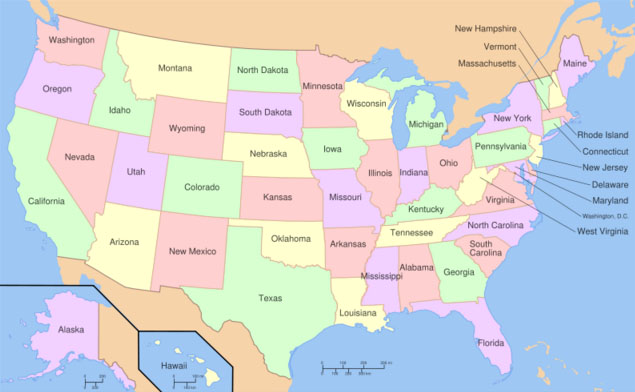Die Flagge von Wyoming
wurde am 31.01.1917 eingeführt, nachdem sie aus einem Entwurfswettbewerb als Sieger
hervorging. Sie zeigt ein einfarbiges blaues Grundtuch mit einem roten Rand, der durch
einen schmaleren weißen Rand von der blauen Fläche getrennt ist. In der Mitte der Flagge
erscheint ein Bison, der das Siegel des Staates trägt. Die Farben der Flagge sind die
Farben der USA, ferner steht Rot für die Indianer und das Blut, das die ersten Siedler
hatten geben müssen, das Weiß steht für Reinheit und Ehrlichkeit, das Blau steht für
Gerechtigkeit, Fleiß, die Berge und den Himmel. Der Bison repräsentiert die Tierwelt des
Landes. Das Siegel zeigt eine allegorische Frauenfigur auf einem Sockel und darüber ein
Banner mit den Worten "Equal rights" => "gleiche Rechte", eine
Anspielung auf das bereits 1869 eingeführte Frauenwahlrecht. Zur Linken und zur Rechten
der Frau ein Viehhirte und ein Bergmann. Die Flagge war einige Male in Details geändert
worden, zuletzt wurde der Bison mit dem Kopf in Richtung Mast gedreht, damit er sich dem
Wind "entgegenstemmt".
The flag of Wyoming was
introduced on 31st of January in 1917, after it emerges as the winner a design
competition. It shows a single-coloured blue bunting with a red border that is separated
by a narrow white border from the blue field. In the middle of the flag is placed a bison
who carries the seal of the state. The colours of the flag are the colours of the United
States, furthermore red stands for the Indians and the blood that was given by the first
settlers, white stands for purity and honesty, blue stands for justice, diligence, the
mountains and the sky. The bison represents the wildlife of the country. The seal shows an allegorical female figure
on a pedestal and above a banner with the words "Equal rights", an allusion to
the women's suffrage, introduced already in 1869. To the left and right of the woman
appears a herdsman and a miner. The flag was changed several times in details, at least
the bison became turned with its head toward the mast, so that he "opposes" the
wind.
 |
